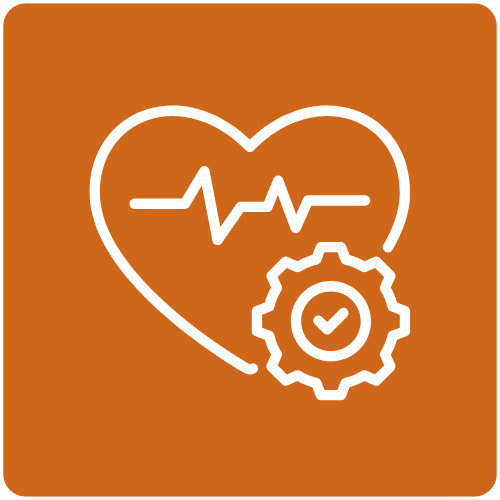
Branson community
The Branson Community includes Taney and Stone counties in Missouri.

PART 1: INTRODUCTION
Executive Summary
Since 2016, hospital systems, local public health agencies (LPHAs) and other health care partners in the greater Ozarks have worked together to release comprehensive Community Health Needs Assessments (CHNAs) every three years. This group, known as the Ozarks Health Commission (OHC), released community-level reports in 2016, 2019 and 2022. For the fourth iteration, the 2025 assessment has been compiled into community-level and regional snapshots, continuing the regional scope introduced in 2022.
Health care partners and LPHAs develop the results of these assessments into Community Health Improvement Plans (CHIPs). Organizations use CHIPs to target areas of health need and disparity in communities and create actionable plans to make them better over time.
The scope of the OHC region includes 33 counties across three states. These counties make up seven different communities, who each develop reports based on their community-level data. Information about data collection can be found in the OHC Regional Report.
Taney and Stone counties make up the Branson Community. The population is serviced by CoxHealth Medical Center Branson, Taney County Health Department and Stone County Health Department.
The following Branson Community report presents key findings for the area and describes the process used to prioritize the top assessed health issues of concern. The document provides local stakeholders and organizations with information necessary to better understand the health needs of the community.

Service Area
The Branson Community is home to 87,142 individuals¹, and its population has grown nearly 4% in the last decade. The area includes state parks, lakes, rural communities, villages, small townships, unincorporated communities and 19 cities, including Branson, Hollister, Forsyth, Galena, Kimberling City and Branson West.
Locals and visitors enjoy diverse recreational and entertainment opportunities. Branson is the most populated city between Stone and Taney counties, with an estimated 12,897 residents in 2023. Stone County makes up approximately 36% of the overall population, while Taney County accounts for 64%.
According to the Branson Convention and Visitors Bureau, in 2023 approximately 10.28 million tourists visited the area.² The Branson Community continues to see an increase in visitors to the area each year. Area officials began tracking the number of annual visitors in 1993. Several tourism attractions are located the Branson Community, including Silver Dollar City, Shepherd of the Hills Homestead, various shopping complexes and dining and live entertainment theatre performances. Many theatres are located along the famous 76 Country Boulevard.

Population overview
The OHC noted several important demographic and population trends within the Branson Community.
Approximately 55% of residents are within the age grouping of 18-64, which drives the workforce in the community. 19% of residents are minors under the age of 17, while 40% are over the age of 55. The Branson Community has more adults over the age of 55 than the state and the nation. Older residents are more likely to be living with chronic illnesses and require access to more health services.
Approximately 18% of the total population is living with a disability, which is higher than the state rate of 15% and the national rate of 13%. This may contribute to access to care and disparities among community members who are disabled. Approximately 20% of males have a disability, while only 16% of females report living with a disability in the Branson Community.

Population GrowtH
.png)
Percentage of population living with a disability
.png)
Populations of interest
Vulnerable populations, such as people in poverty, minorities and the elderly often experience higher rates of chronic illness and worse health outcomes. To ensure vulnerable and at-risk populations were considered when identifying and addressing community health needs, the OHC identified groups in each community using the Centers for Disease Control and Prevention (CDC) Social Vulnerability Index (SVI).
Using U.S. Census and American Community Survey data, the SVI identifies the most vulnerable groups across all comparative census tracts. Out of the highest vulnerability score of 1.0, the Branson Community has an overall SVI score of 0.67, meaning this community is more vulnerable than 67% of the OHC region. Comparatively, the state’s SVI is 0.44 and the nation is 0.58. The SVI score is an area of concern for the Branson Community.


PART 2: Areas of focus

PART 2: Areas of focus
The Branson Community held a prioritization meeting on Feb. 4, 2025, to review identified health priorities. The data collected was presented at the OWNit meeting and was attended by several partner agencies throughout Stone and Taney counties. Participants were given access to a Mentimeter survey to rank the top three health priorities based on the communities’ Ability to Impact and Level of Harm. The survey was open to participants throughout the week to allow for the surveys to be completed.
The Branson Community selected three top health priorities: Behavioral health (mental health and substance use), heart health and diabetes. This assessment combines qualitative data in the form of partner agency and community surveys as well as secondary data collection to realize a full scope of the needs in the community.
Each priority is listed below with supporting statistics demonstrating the disparities in the Branson Community. These priorities will be incorporated into a CHIP between the respective health departments and health systems.

Behavioral health

Heart health

Diabetes
Behavioral health
Behavioral health—including mental health and substance use—continues to be a top priority among the Branson Community. There are several root causes that can contribute to mental distress, substance use and behavioral health which may lead to death.

Poverty

Access to care

Education

Non-health care costs
Percentage of adults age 18+ with poor mental health
.png)
Deaths of despair
.png)
Poverty
Approximately 38% of the population lives below the poverty line. Poverty can lead to chronic stress, lack of access to healthcare and inadequate living conditions, all of which contribute to mental health problems. Unemployment affects 5% of people in the Branson Community, which can lead to financial stress and feelings of hopelessness, worsening mental health issues. Lack of insurance can prevent individuals from accessing necessary mental health services. 13% of the population is uninsured in the Branson Community.
Access to care
The rate of mental health providers in the Branson Community is 36.72 per 100,000, which is much lower compared to the OHC region at 132.87. Some underserved areas may have shortages while others do not, making it difficult for individuals to receive timely and effective treatment. The Community Survey identified access to care and provider availability as a barrier.
Education
Approximately 10% of the population aged 25 and older do not have a high school diploma, while only 9% of the state do not have a high school diploma. Lower levels of education are associated with higher rates of mental health issues due to limited job opportunities and economic instability.



Non-health care costs
Childcare costs, lack of access to food and homelessness are additional barriers which may worsen mental health issues. Childcare costs account for 29% of household income in the Branson Community. High childcare costs can lead to financial stress and impact parents’ mental health. At least 14% of the Branson Community has low food access. Low food access includes those who experience food insecurity or have a lack of consistent access to affordable, nutritious food. Food insecurity can lead to poor nutrition, which affects mental health and overall well-being. Also, almost 10% of the students in the Branson Community are homeless, compared to only 5% of the OHC region. Lack of housing can significantly impact students’ mental health and educational attainment. Housing instability leads to chronic stress and worsens mental health issues.
Lack of social support and community connections can lead to feelings of loneliness and depression. Communities with limited social support networks often see higher rates of mental health issues. The “deaths of despair” indicator shows an average rate of death due to intentional self-harm, alcohol-related disease, and drug overdose per 100,000 population.
The crude death rate in the Branson Community is 63.3 per 100,000 population. Individuals with substance use disorders often have co-occurring mental health issues, which can complicate treatment and recovery. 15% of adults report excessive drinking, while 21% of adults report smoking. The age-adjusted death rate for drug overdose is 31.89 per 100,000 population. Substance use issues can worsen mental health issues.
There are strategies both Stone and Taney County Health Departments have implemented to combat mental health distress and self-harm in their communities. Stone and Taney County utilize the Question, Persuade, Refer (QPR) suicide prevention training program. The QPR program equips family and friends with tools to recognize signs and symptoms of someone having suicidal thoughts. It also shows them how to take immediate action to refer loved ones to help to prevent self-harm and death. Taney County has trained over 1,000 community members in QPR since implementation in 2022.
Additionally, the 988 Suicide and Crisis Lifeline is available 24 hours a day, seven days a week to provide judgement-free care and support for mental health and substance use issues.
Heart health
Similar to the Springfield Community, the Branson Community experiences higher rates of heart disease. The heart disease mortality indicator shows that crude death rates in the Branson Community (409.8 per 100,000) are higher than the state (252.6 per 100,000) and the nation (206.7 per 100,000) and is an area of concern. The rate of primary care providers is 74.59 per 100,000 population, which may be insufficient to meet the community’s needs in reducing the rates of heart disease. Approximately 13% of the population is uninsured, limiting access to preventive care and management of heart conditions.

HEART DISEASE MORTALITY
.png)
Coronary heart mortality
.png)
Coronary heart disease
Coronary heart disease mortality crude death rates in the Branson Community (178.9 per 100,000) is higher than the state and the nation. Coronary heart disease is also known as ischemic heart disease, which is defined as damage to the heart due to the narrowing of the heart arteries.
Lack of access to healthy foods, higher body mass index among individuals and reduced physical activity may contribute to heart diseases over time. The percentage of the low-income population with low food access is 33%, indicating significant gaps in access to healthy food options, which can contribute to poor nutrition and obesity. Obesity in the Branson Community is 28%, while 33% of the state is classified as obese. Obesity is a significant risk factor for heart disease, diabetes and stroke. Furthermore, 20% of adults report no leisure-time physical activity, contributing to sedentary lifestyles and obesity.
Substance use is reported among the Branson Community. Approximately 15% of adults report excessive drinking, which can contribute to heart disease. Additionally, adults aged 18+ who are current smokers make up 21% of the population, which is a major risk factor for heart disease.
Stone and Taney counties continue to promote chronic disease prevention through ongoing programs for screenings, which are targeted to various populations across the community. Both counties participate in statewide programs such as Show-Me Healthy Women (SMHW) and Women’s Wellness Exams, while Taney County also participates in the Wise Woman (WISEWOMAN) Program. The SMHW program promotes screening services for women aged 21-64 for early detection of cancers in women. The WISEWOMAN program is a heart disease prevention program, providing screenings for women aged 35 and older. Other screenings may include blood pressure screenings.

Diabetes
Diabetes is a chronic condition known to have broad impacts on physical, social and mental well-being. It causes significant morbidity and mortality in the United States as the eighth leading cause of death. According to County Health Rankings in 2021, approximately 11% of Branson Community adults aged 20 and above were diagnosed with diabetes. ³,⁴ The percentage of Medicare enrollees with diabetes with an annual A1C test in the Branson Community is almost 88%, which is just lower than the state.

A significant portion of the population lives below the poverty line (38%). Poverty can limit access to medical care due to the inability to afford doctors’ visits and medications. The rate of primary healthcare providers is 74.59 per 100,000 population. In underserved areas, the availability of providers may be even lower, making it difficult for residents to access care.
Lower levels of education are associated with lower health literacy which can affect individuals’ understanding of the importance of managing diabetes. In the Branson Community, approximately 10% of the population aged 25 and older do not have a high school diploma.
Poor dietary habits, such as high sugar consumption over time, can contribute to diabetes. Limited access to affordable, healthy foods can contribute to poor nutrition which affects diabetes. The percentage of the low-income population with low food access is 33%, indicating significant gaps in access to healthy food options, which can contribute to higher A1C levels. ⁵
Stone and Taney counties continue to promote chronic disease prevention through its ongoing programs for screenings which are targeted to various populations across the communities. Stone and Taney counties offer mobilized services as needed.
Percentage of Medicare Enrollees with Diabetes with annual A1C Test
.png)

PART 3: Closing Remarks

Conclusion
While this overview of health in the Branson Community is not comprehensive, it gives an important glimpse into areas of concern reflected in both data and community feedback. The 2025 assessment will be used to inform public health and health care initiatives. These initiatives will be outlined in a forthcoming Community Health Improvement Plan.
Dissemination
The OHC regional report and all community-level reports are available to the public through various channels
Websites
Ozarks Health Commission
CoxHealth
Stone County Health Department
stonecountyhealthdepartment.com
Taney County Health Department
Printed copies
Printed copies will be available by request through health care partners and LPHAs. Please refer to organization websites or contact an organization directly
Social media
CoxHealth
Stone County Health Department
facebook.com/stonecohealthdept
Taney County Health Department
Health services available
Burrell Behavioral Health
CoxHealth
Hope Counseling Center
Jordan Valley Community Health Center
Mercy
Stone County Health Department
stonecountyhealthdepartment.com
Taney County Health Department

AckNowledgements
Thank you to Branson Community partners and residents for contributing to this assessment through your feedback. Your contributions provide rich context to the vast health care data compiled for this report.
Thank you to the OHC Steering Committee for your collaboration and resource sharing during every step of the CHNA process.
Thank you to the Branson Community representatives in the OHC steering committee for your contributions toward data collection and creation of the report.
Citations
¹ American Community Survey. 2019-2023.
² “Branson Convention & Visitors Bureau. Branson/Lakes Area CVB Key Performance Indicators. (n.d.). https://www.bransonmo.gov/DocumentCenter/View/18957/2023-Year-End-Marketing-Report-PDF.
³ Taney, Missouri. County Health Rankings & Roadmaps. (n.d.). https://www.countyhealthrankings.org/health-data/missouri/taney?year=2024.
⁴ Stone, Missouri. County Health Rankings & Roadmaps. (n.d.). https://www.countyhealthrankings.org/health-data/missouri/stone?year=2024.
⁵ The impact of food insecurity. The Impact of Food Insecurity | ADA. (n.d.). https://diabetes.org/diabetes-financial-impact/impact-food-insecurity.
